Last updated: January 12, 2024
Article
The Oasis Newsletter: Fall 2022

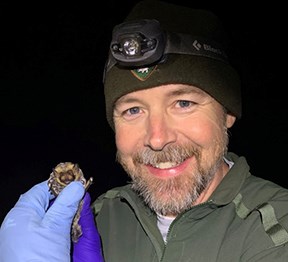
Program Manager's Corner
Wow, I have been the program manager here at MOJN for over 6 years now. In some ways, it feels like just yesterday that I walked into our humble trailer at Lake Mead National Recreation Area, having no idea what I was getting myself into. In other ways, I’ve seen how much the Mojave Desert Network (MOJN) has accomplished since then. And all of this because of the great team we have here. We were a network in transition. Only three protocols had been fully published, with one other that had begun to be implemented but protocol documents were still in draft form. One other protocol was in the planning stages, and I had found out that we only had until the end of 2017 to have all protocol documents drafted. On top of that, there were two more protocols that we were being asked to add to our plate. It seemed daunting, especially with our ecologist position being vacant for multiple years. Being brand new to the National Park Service and the Inventory & Monitoring Program, I had to rely heavily on our team. While I’ve never been sailing, I feel like being an Inventory & Monitoring (I&M) network program manager is kind of like being the captain of a sailing ship. Your primary job is to steer the ship, but it takes a team to get the boat to actually turn in the direction you want to take it.
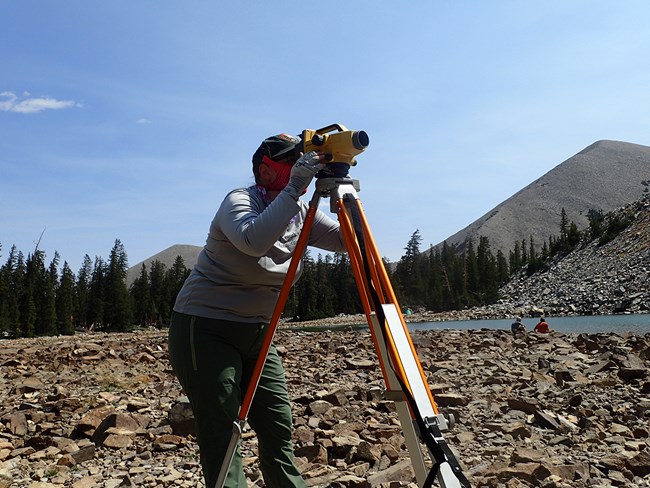
NPS / Marisa Monroe
Protocols Published, Implemented, and Improved
We were successful in getting all seven protocols published within the required time frame. But on top of that, I also helped acquire funding to develop a network-wide bat monitoring plan. While not an I&M specific protocol, it is a collaboration with the parks to coordinate monitoring methods across the network and follow an already established continent-wide monitoring program. We have now been running this monitoring project for five years and have secured additional funding through FY26. While managing eight different monitoring projects, you’d think we would maybe just sit back and follow the guidelines that each protocol had initially stated we would. But our team has been actively improving these protocols in myriad ways, including updating our methodologies for how we collect lake level data at Great Basin National Park from using strings to employing laser levels, as well as transitioning most of our data collection to electronic field entry, increasing accuracy and efficiency.
While it will take many years before we can statistically evaluate most of our data for status and trends, we have been able to assist parks with other information as our crews go out to some remote areas of our vast parks. Examples include collecting bighorn sheep scat, assessing cultural sites that overlap with our desert springs monitoring, and reporting observations of non-native species such as burros or invasive plants.
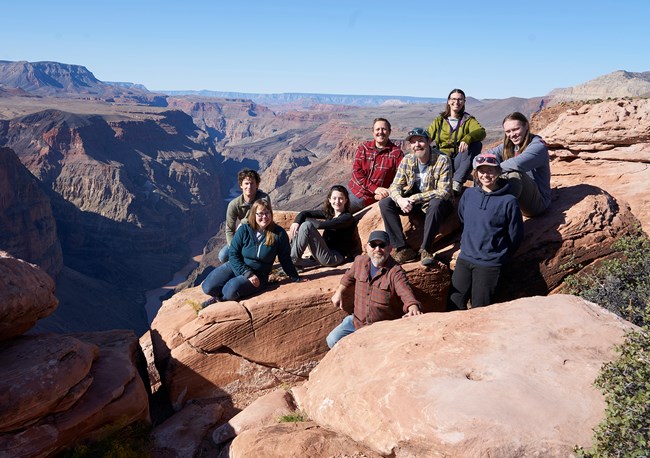
NPS / Mark Lehman
Teamwork has helped us adapt to change.
And we can’t forget to mention the “P” word that has impacted our work in multiple ways since the world shut down briefly, starting in March of 2020. We did lose some data points which will push back when we can do some analyses, but our crews did all they could to get back into the field as quickly as possible while also following guidelines and minimizing our team’s risk of becoming infected with SARS-CoV-2. We also became accustomed to the brave new world of virtual offices and teleworking. Our team quickly adapted to these conditions and found ways to still feel connected as a team with weekly “coffee” breaks and brown bag sessions. As we began to return to the office more frequently, many of us found ways to hybridize our work schedules.
And just as we were settling into our new normal work environment, I had to throw a monkey wrench into the mix. My wife was offered a position in a PhD program across the country in Binghamton New York, and this past summer we packed up our family, moved, and I began working almost entirely remote. While I admit that it isn’t ideal to try and steer a ship that you aren’t physically standing on, I am grateful that technology makes it feasible, and for the practice I got during the first year and a half of the pandemic. But again, if it wasn’t for this great team and for the experience working together these last 6 years, it would not have been possible to try this remote situation out. It was great being back in person for the network Science Symposium last month, and I will be returning as needed to ensure our ship has everything it needs for this great voyage we are on.
To close, I want to use one of the cheesiest sayings or mantras that really does sum up how I feel about my opportunity to lead this network, and I think it’s best summed up with this gif:

via GIPHY - https://giphy.com/gifs/eppendorf-laboratory-sciencelab-eppi-0vIBGLAsnoVWGBGoyR
Thanks to the MOJN Dream Team!
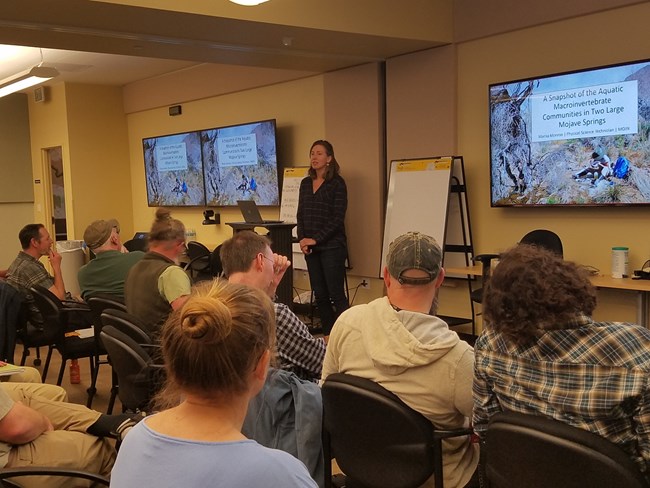
MOJN hosts its second in-person science symposium.
On November 2-3, 2022, around 80 people attended the Mojave Desert Network's second in-person science symposium in Boulder City, Nevada. There was great enthusiasm to gather again for the first time since 2019, when the first symposium occurred. Attendees represented five different federal agencies, three universities or colleges, the Southern Nevada Water Authority, one private botanical studies program, and four partner organizations that provide early-career work opportunities in parks.
Participants presented 21 talks and four posters on a variety of topics, including restoration projects, paleontological inventory, wildlife monitoring or habitat modelling, invasive species management, a climate change response program, desert springs monitoring, vegetation monitoring, managing for greatly increased visitation in parks, and more. Five Mojave Desert Network staff presented updates or a poster on desert springs, desert spring vegetation, springs macroinvertebrate communities, and bat monitoring projects, and the new Inventory & Monitoring Division Lead Meg White provided her early perspectives on the national program and where it is headed.
The presentations were not recorded, but if interested in more detail about the posters and presentations, download the 2022 Mojave Desert Network Science Symposium Abstracts. The meeting agenda is also available. The symposium received predominantly favorable reviews. Here are sample responses to What one or two things did you learn that really sparked your interest or will help you in your own work?:
- Can my answer be all of the presentations? As someone just joining the region I really got a lot out of each presenter. Learning about the unique challenges in the Mojave desert was great timing.
- I just love seeing what everyone is up to in their corners of the desert -- management actions, monitoring, etc.
- All of the talks on desert springs ecosystems were very useful and interesting.
- Refreshed connections with services provided by Pacific West Region and the Washington Office. Terrific seeing their attendance, really indicated their support and desire to strengthen connections with MOJN parks.
- Big projects such as working to redo fire management, implementing stream bank restoration, and managing for climate change.
- Learning about the continuation of monitoring through the decades is encouraging.
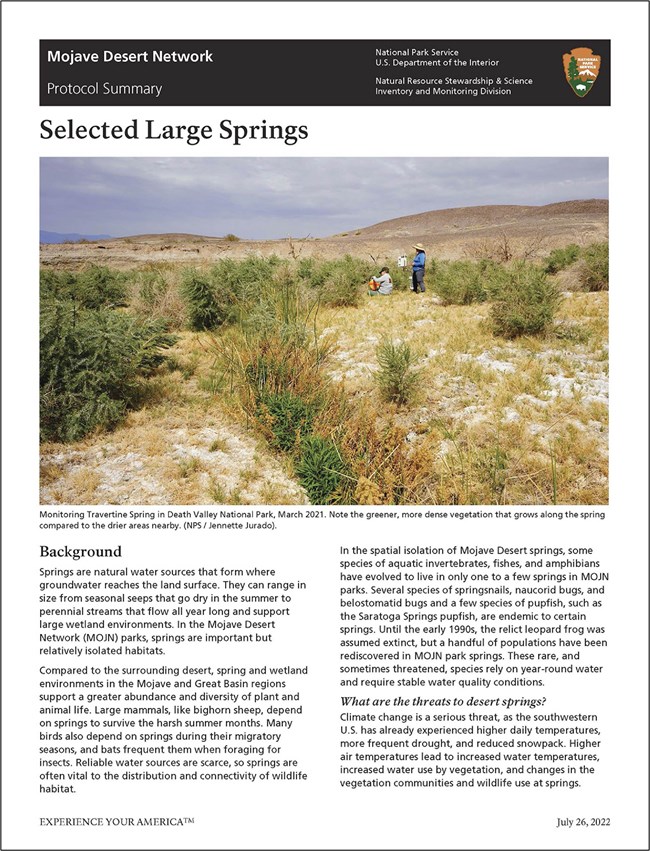
New Project Brief: Selected Large Springs Monitoring
Last summer, we published a project overview brief about selected large springs monitoring in MOJN. MOJN monitors 15 large springs in six network parks – Death Valley, Great Basin, Joshua Tree, Lake Mead, Mojave, and Parashant. Guided by park input on management priorities, the springs selected include those with the highest and most reliable discharge.
Given the ecological importance of springs and the threats they face from climate change, drought, and land use impacts, MOJN’s goal is to help inform resource management decisions and strategies by addressing the following monitoring questions:
- Is the hydrology of any of the selected large springs in the MOJN parks changing?
- Is the overall ecological condition of any of the selected large springs in the MOJN parks changing?
Learn more by reading the brief or visiting our Selected Large Springs Monitoring web page.
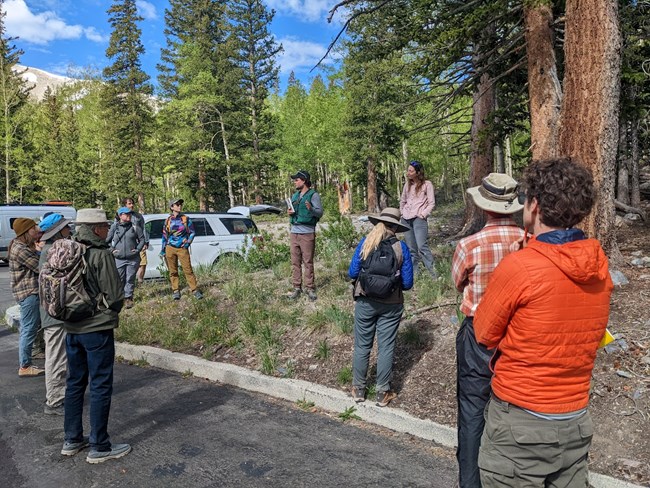
NPS / Joseph Ladd
MOJN staff participate in outreach events.
Forest Health BioBlitz at Great Basin National Park
While at Great Basin National Park to monitor white pines last June, the vegetation monitoring crew contributed to the park's BioBlitz event. BioBlitzes connect people to national parks or other public lands, provide outreach on park natural resources, and generate data for science and conservation. MOJN's Vegetation Ecologist Jeff Galvin presented an overview of white pine monitoring protocol and how and why MOJN monitors these communities; he also shared some preliminary results. In addition, Jeff and Joe Ladd (MOJN Biological Science Technician) hosted a field trip where they demonstrated the methods used to sample white pine and aspen plots.
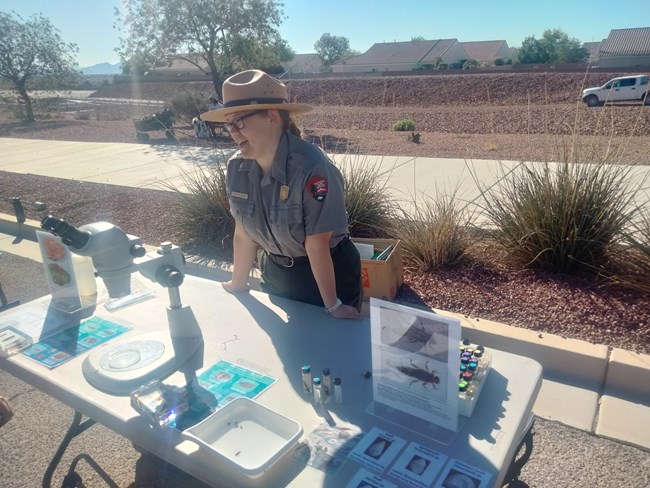
NPS / Marisa Monroe
National Fossil Day at Tule Springs Fossil Beds National Monument
Two MOJN staff participated in Tule Springs Fossil Beds National Monument’s National Fossil Day event in early October. The Pleistocene Palooza celebrated the ancient animals and environments of Tule Springs and the science behind what is known about this place and its fossil record. Jennifer Bailard and Marisa Monroe hosted a popular Bug Booth, highlighting aquatic invertebrates. For this event for all ages, people showed up to discover what remains of Ice Age Las Vegas.
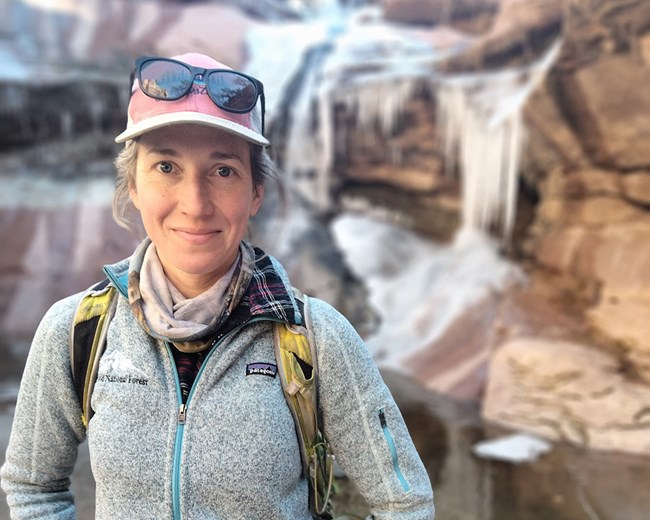
New Opportunities for Two MOJN Staff
Marisa Monroe
Last February, Marisa Monroe was promoted to the lead Physical Science Technician for the network's aquatic monitoring projects. In this role, she leads the logistics and planning for MOJN's Desert Springs, Selected Large Springs, and Streams and Lakes projects. She also performs quality control on continuous stream and lake hydrology data and helps maintain the network's water quality monitoring equipment.
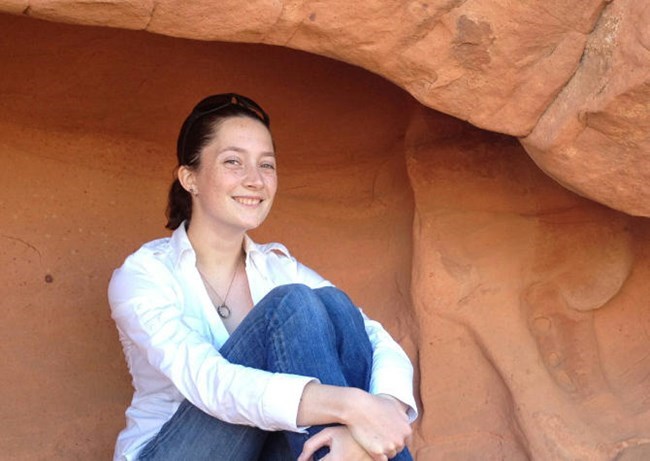
Sarah Wright
Data Scientist Sarah Wright, whose time is shared among MOJN and seven other networks, accepted a detail with the Inventory & Monitoring Division Central Support Office that started in early October and will end in early February. She has worked on several data projects, including the creation of the IMData Microsoft Team and the Data Science Hub SharePoint site. Together, the team and SharePoint site will serve as a place for data practitioners to ask questions and share resources. Sarah has also contributed to the NPS Dataverse R packages, which provide NPS-specific tools for working with data packages and metadata.
Fall and Winter Field Schedule
| Park | October | November | December | January | February | March |
| DEVA | – | Desert Springs | – | – | Bats1, Desert Springs, Selected Large Springs | Bats2 |
| GRBA | – | – | – | – | Bats1 | – |
| JOTR | – | Desert Springs | Desert Springs, Selected Large Springs |
Bats1, Desert Springs | – | Selected Large Springs |
| LAKE | – | – | Selected Large Springs |
– | Bats1 | Bats2, Selected Large Springs |
| MANZ | – | – | – | – | – | – |
| MOJA | – | – | Selected Large Springs | Bats1 | Desert Springs | Selected Large Springs |
| PARA | – | Selected Large Springs | – | Bats1 | Desert Springs, Selected Large Springs | Integrated Uplands Recon |
2Capture
Highlights and Farewell
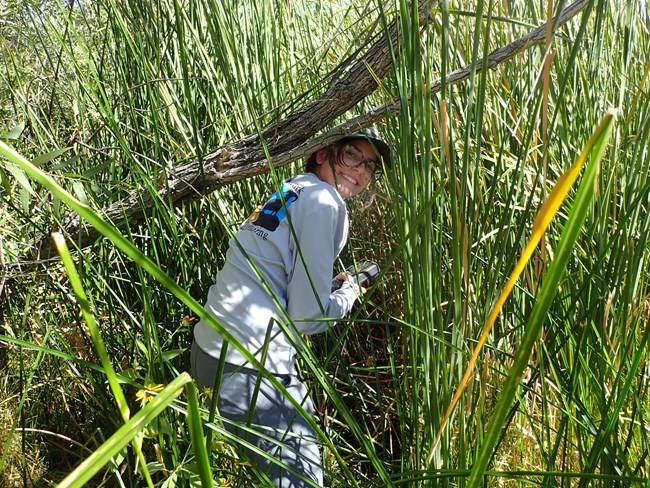
Data Assistant Sierra Moore shares internship highlights.
Sierra Moore joined MOJN as a Data Assistant through the Scientists-in-Parks internship program last June. As an undergraduate student studying Wildlife Conservation at Virginia Tech, she became interested in pursuing a career that would enable her to combine her interests in data science and conservation. Her internship at MOJN gave her a good start down that path. Sierra's last day with us was December 2nd. We thank her for all the data projects she helped us complete, and for occasional support on field projects as well as our science symposium. Learn more about Sierra's work below, in her own words:
Over the past six months I have assisted the data team at MOJN with a variety of data science and management tasks. Some of the projects that I worked on included:
-
Creating electronic data entry forms using Survey123, which saves time and helps reduce error with data collection in the field and with data entry in the office
-
Migrating a database from SQL Server to ArcGIS Online which will allow for a more efficient flow of data from data collection in the field into a managed database
- Creating web experience dashboards for the Desert Springs protocol which will allow for the hydrology team to explore and query their data in a user-friendly way
- Helping to update an R package that facilitates quality assurance/quality control of Desert Springs data
In the process of working on a wide range of projects, I gained skills with new software, programming languages, and data management practices that will be invaluable to my career. In addition to the experience I gained through these data science projects, I had the opportunity to learn more about vital signs monitoring in national parks while assisting MOJN personnel with ecological data collection in the field. My time at MOJN has been a very rewarding experience that has not only allowed me to build on my data science and management skills but also given me valuable professional knowledge of the natural resource/conservation field. I am grateful for the connections I made while working at MOJN, and while I'm sad to leave, I'm excited to see where the skills and knowledge I gained during my time here take me next.
Welcome, Katie and Hanna!
Our hydrology monitoring team welcomed two new staff in late October. From monitoring springs in snow and cold temperatures after a winter storm in Death Valley to assisting with our science fall symposium, Katie and Hanna have jumped in to help with enthusiasm and good humor.
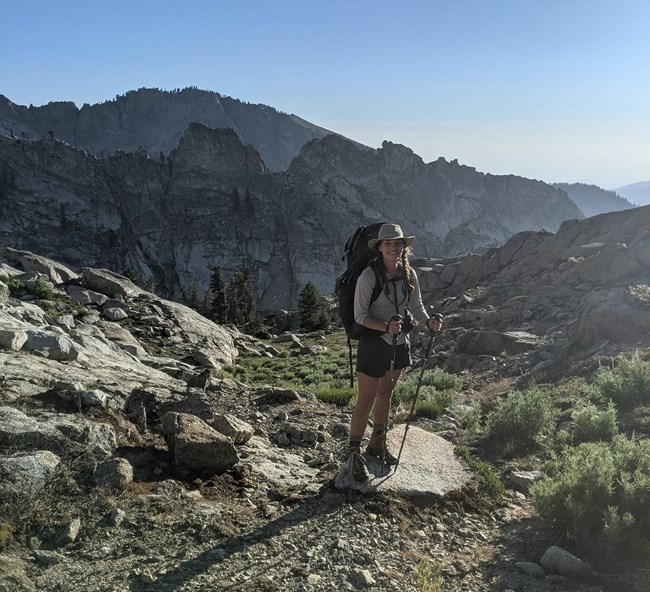
Katherine (Katie) Dagastino
Katie is our new Physical Science Technician, assisting with all water resource projects – Desert Springs, Selected Large Springs, and Streams and Lakes. She has a BA in Earth Sciences with an emphasis in geology. Katie began her National Park Service career in 2016 as a seasonal interpretive ranger at Oregon Caves National Monument and Preserve. Since then, she has worked in several parks and forests in a variety of programs such as recreation, endangered species monitoring, water quality, and conservation, as well as wildland firefighting. In her free time she enjoys hiking, backpacking, learning to mountain bike, singing, and spending as much time as she can in nature.
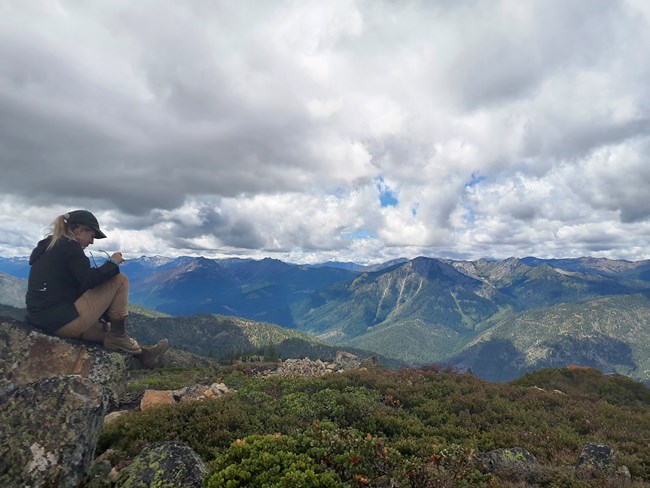
Hanna Buccowich
Hanna Buccowich joins MOJN as a Hydrology Assistant through the Conservation Legacy internship program. She assists with field data collection and data management for the Selected Large Springs and Desert Springs projects. Hanna graduated last December with a BS in Biology, emphasizing Ecology, Evolution, and Behavior. Her first job out of school brought her to the Mojave Desert, where she monitored desert tortoise populations. She next worked on a botany crew in the Klamath and Shasta-Trinity National Forests, mapping and managing invasive species on burn sites. She is thrilled to be back in the Mojave Desert. Outside of work, Hanna enjoys spending time in nature, hiking, reading, and finding new recipes.Farewell, Sarah, Ashley, Gabriel, and Natalie!
Sarah Barsch, Bat Technician with Great Basin Institute, and Ashley O'Brien, Conservation Legacy Intern, worked on our bat monitoring project. Thank you for your hard work in numerous MOJN parks, carrying and setting up monitoring equipment and collecting both acoustic and capture data. Gabriel Elliott, Vegetation Technician with Great Basin Institute, and Natalie Kim, Conservation Legacy Intern, both worked on MOJN vegetation monitoring projects, including Integrated Upland Vegetation, Spring Vegetation, White Pine, and Aspen. Thank you for your hard work on a variety of vegetation monitoring projects, from desert shrublands to subalpine white pines! Happy Trails to all!

NPS / Kimber Godfrey

NPS / Joseph Ladd
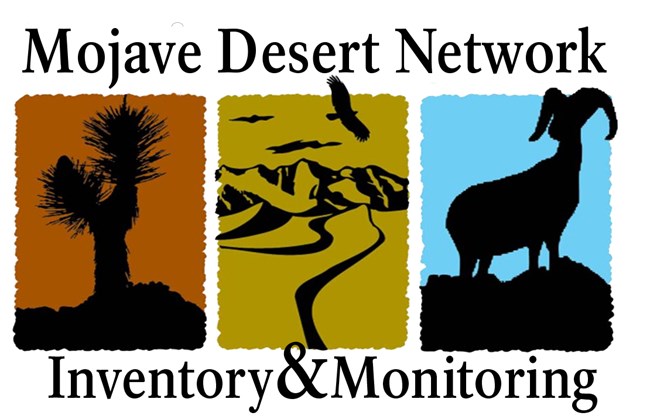
Newsletter prepared by Linda Mutch and Lise Grace
NPS Mojave Desert Inventory & Monitoring Network
601 Nevada Highway
Boulder City, Nevada 89005
